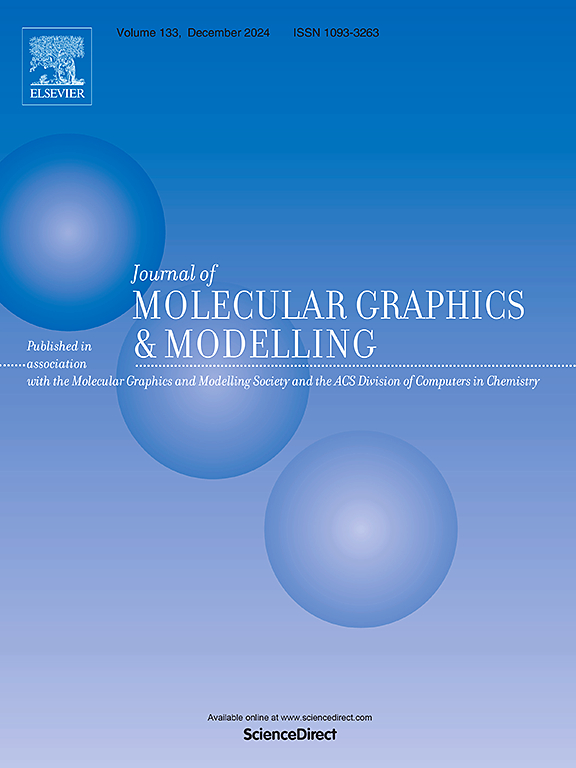A comprehensive investigation of structural, mechanical and optoelectronics attributes of M2AsC (M = Zr, Hf, Ta, W) MAX phase carbides: A DFT investigation
IF 3
4区 生物学
Q2 BIOCHEMICAL RESEARCH METHODS
引用次数: 0
Abstract
This research utilizes first-principles calculations to systematically investigate the phase stability, mechanical properties, and optoelectronic characteristics of the M2AsC (M = Zr, Hf, Ta, and W) MAX phase carbides. The phase stability of these M2AsC compounds is evaluated through the computation of formation enthalpies, which demonstrates that all analyzed compounds exhibit both structural and thermodynamic stability. To evaluate mechanical stability, we calculated the elastic stiffness constants, confirming the mechanical robustness of the studied MAX phases. Furthermore, the calculated Pugh and Poisson ratios reveal a brittle nature for Hf2AsC and Ta2AsC materials, while Zr2AsC and W2AsC compounds display notably high B/G ratios, indicating superior hardness relative to the other compounds studied. The band structure and density of states analyses confirm a metallic character for all M2AsC compounds. A prominent hybridization effect is identified between the d-orbitals of M and the p-orbitals of C, while the interaction between the p-orbitals of M and As is comparatively less significant. The presence of pseudogaps near the Fermi level is linked to the orbital hybridization involving M, As, and C atoms. Charge density difference maps further elucidate the strong covalent bonding between M and C atoms, contrasted by a relatively weaker bonding interaction with As atoms. Additionally, a comprehensive examination of optical properties reveals that the highest absorptivity occurs within the energy range of 7.5–20 eV. The optical spectra of the MAX phases span from 1.7 eV in the infrared region to 11 eV in the ultraviolet region, indicating their potential as effective energy absorbers in the UV spectrum. Overall, the distinctive properties exhibited by M2AsC compounds suggest their viability for a broad spectrum of applications across diverse fields.

M2AsC (M = Zr, Hf, Ta, W) MAX相碳化物结构、力学和光电特性的综合研究:DFT研究
本研究利用第一性原理计算系统地研究了M2AsC (M = Zr, Hf, Ta, and W) MAX相碳化物的相稳定性、力学性能和光电特性。通过生成焓的计算对这些M2AsC化合物的相稳定性进行了评价,结果表明所分析的化合物都具有结构稳定性和热力学稳定性。为了评估机械稳定性,我们计算了弹性刚度常数,证实了所研究的MAX相的机械鲁棒性。此外,计算的Pugh和泊松比显示Hf2AsC和Ta2AsC材料具有脆性,而Zr2AsC和W2AsC化合物具有显著的高B/G比,表明相对于所研究的其他化合物具有更高的硬度。带结构和态密度分析证实了所有M2AsC化合物的金属性质。M的d轨道和C的p轨道之间存在明显的杂化效应,而M和As的p轨道之间的相互作用相对不太显著。费米能级附近赝隙的存在与涉及M、As和C原子的轨道杂化有关。电荷密度差图进一步阐明了M和C原子之间的强共价键,与之形成对比的是与As原子之间相对较弱的键相互作用。此外,对光学性质的综合研究表明,在7.5-20 eV的能量范围内,吸收率最高。MAX相的光谱范围从1.7 eV的红外区到11 eV的紫外区,表明它们在紫外光谱中具有有效吸收能量的潜力。总的来说,M2AsC化合物表现出的独特性质表明它们在不同领域的广泛应用是可行的。
本文章由计算机程序翻译,如有差异,请以英文原文为准。
求助全文
约1分钟内获得全文
求助全文
来源期刊

Journal of molecular graphics & modelling
生物-计算机:跨学科应用
CiteScore
5.50
自引率
6.90%
发文量
216
审稿时长
35 days
期刊介绍:
The Journal of Molecular Graphics and Modelling is devoted to the publication of papers on the uses of computers in theoretical investigations of molecular structure, function, interaction, and design. The scope of the journal includes all aspects of molecular modeling and computational chemistry, including, for instance, the study of molecular shape and properties, molecular simulations, protein and polymer engineering, drug design, materials design, structure-activity and structure-property relationships, database mining, and compound library design.
As a primary research journal, JMGM seeks to bring new knowledge to the attention of our readers. As such, submissions to the journal need to not only report results, but must draw conclusions and explore implications of the work presented. Authors are strongly encouraged to bear this in mind when preparing manuscripts. Routine applications of standard modelling approaches, providing only very limited new scientific insight, will not meet our criteria for publication. Reproducibility of reported calculations is an important issue. Wherever possible, we urge authors to enhance their papers with Supplementary Data, for example, in QSAR studies machine-readable versions of molecular datasets or in the development of new force-field parameters versions of the topology and force field parameter files. Routine applications of existing methods that do not lead to genuinely new insight will not be considered.
 求助内容:
求助内容: 应助结果提醒方式:
应助结果提醒方式:


